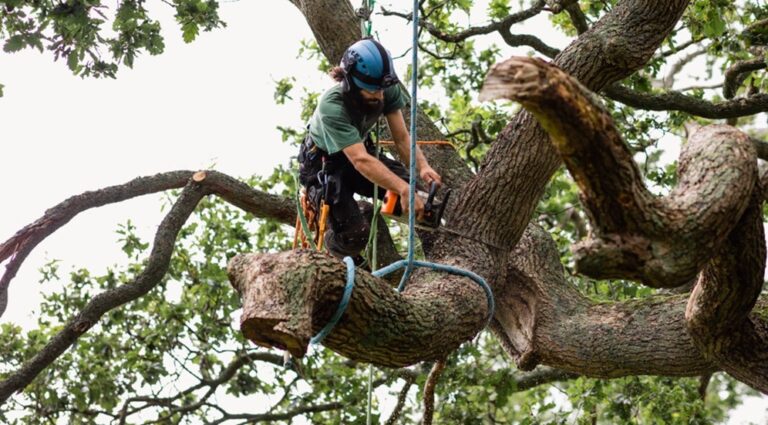Trees, with their majestic beauty and ecological significance, enhance the landscape around our properties. They provide shade, improve air quality, and offer habitats for various creatures. However, as much as they contribute positively to our surroundings, trees can also pose risks, especially when they are not properly maintained. One of the most effective ways to mitigate these risks is through regular tree inspections. In this blog post, we’ll delve into the importance of inspections in safeguarding against property damage and liability.
Understanding the Need for Tree Inspections
Trees, like any living organism, are subject to various factors that can affect their health and stability. These factors include diseases, pests, structural weaknesses, and environmental conditions such as storms and soil erosion. Without proper attention, these issues can escalate, leading to hazardous situations that endanger both property and lives.
Inspections are systematic assessments conducted by certified arborists or trained professionals to evaluate the health, structure, and safety of trees. These inspections involve a thorough examination of the tree’s trunk, branches, roots, and overall condition. Through careful observation and assessment, potential risks can be identified and addressed proactively.
Identifying Potential Hazards
One of the primary objectives of tree inspections is to identify potential hazards that could lead to property damage or personal injury. Dead or decaying branches, cracks in the trunk, and root damage are common indicators of a tree’s compromised structural integrity. Additionally, signs of disease or infestation, such as abnormal leaf discolouration or fungal growth, can signal underlying issues that need attention.
By conducting regular inspections, property owners can stay ahead of potential hazards and take appropriate measures to mitigate them. Prompt removal of hazardous branches or trees can prevent accidents such as falling limbs or uprooting during storms, thereby reducing the likelihood of property damage and liability claims.
Mitigating Liability Risks
Property owners have a legal obligation to maintain their premises in a reasonably safe condition to prevent harm to others. Failure to address known hazards, including unsafe trees, can result in liability for any damages or injuries that occur as a result. Tree-related incidents, such as branches falling on neighbouring properties or pedestrians, can lead to costly lawsuits and compensation claims.
By conducting regular inspections, property owners demonstrate due diligence in fulfilling their duty of care. Documenting inspection reports and taking corrective actions as needed can provide evidence of proactive measures taken to prevent foreseeable accidents. This proactive approach not only helps mitigate liability risks but also promotes a culture of safety and responsibility within the community.
Preserving Tree Health and Longevity
Beyond risk mitigation, tree inspections play a vital role in preserving the health and longevity of trees. Early detection of diseases, pests, or structural issues allows for timely intervention, which can help save affected trees and prevent further damage. Trained arborists can recommend appropriate treatments, such as pruning, fertilization, or pest control, to address specific issues and promote tree health.
Regular inspections also enable property owners to assess the overall condition of their trees and identify any factors that may be affecting their growth and vitality. By addressing environmental stressors, such as poor soil quality or inadequate watering, property owners can create optimal conditions for tree growth and ensure their long-term sustainability.
Collaborating with Certified Arborists
Tree inspections are best conducted by certified arborists or qualified tree care professionals who have the expertise and experience to assess tree health and safety accurately. These professionals undergo rigors training and adhere to industry standards and best practices in arboriculture.
When hiring an arborist for inspections, it’s essential to verify their credentials and experience in the field. Look for certifications from reputable organisations such as the International Society of Arboriculture (ISA) or the Tree Care Industry Association (TCIA). Additionally, consider their track record and customer reviews to ensure reliability and quality service.
Investing in Preventive Tree Care Measures
In addition to regular inspections, investing in preventive tree care measures can further enhance the safety and longevity of trees on your property. Pruning, for example, helps remove dead, diseased, or structurally weak branches, reducing the risk of breakage and promoting healthy growth patterns. Proper pruning techniques also contribute to tree aesthetics and overall structural integrity.
Other preventive measures may include mulching to retain soil moisture, soil aeration to improve root health, and supplemental watering during dry periods. Implementing these practices not only reduces the likelihood of tree-related hazards but also fosters a nurturing environment for tree growth and resilience. Consulting with arborists or tree care professionals can provide guidance on the most suitable preventive measures for your specific property and tree species.
Conclusion
In conclusion, tree inspections are indispensable for safeguarding against property damage and liability risks associated with trees. By conducting regular assessments of tree health and safety, property owners can identify potential hazards, mitigate risks, and preserve the vitality of their trees. Collaborating with certified arborists ensures accurate assessments and adherence to industry standards. Ultimately, investing in inspections demonstrates a commitment to safety, environmental stewardship, and responsible property management. So, let’s stay rooted in safety by prioritising regular inspections for the well-being of our properties and communities.


Comments are closed.